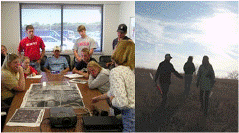Environmental and Sustainability Studies Program

Department of Environmental Studies: Undergraduate Student Theses
Date of this Version
5-2022
Document Type
Thesis
Citation
Environmental Studies Undergraduate Student Thesis, University of Nebraska-Lincoln, 2022
Abstract
Humans have altered 40% of land across the globefor cropland, rangeland, and pastureland, which, in turn, affects amphibious species like the western tiger salamander (Ambystoma mavortium; WTS)and their viable habitats.Since intensive agriculture increased throughout eastern Nebraska in the 1980’s, the distribution ofA. mavortiumhas declined and the species can no longer be found in the southeast corner of the state, while populations are thriving in the pastures of the Sandhills region. Here we explorethe potential factors contributing to the decline ofA. mavortiumthrough the analysis of climaticand soil characteristic data across the geographic distribution of WTS. Data indicated that precipitation rates, soil texture and habitat typemay contribute more than other factors when determiningcontributions to the decline ofA. mavortiumin Nebraska. These factors were variablewhen comparing southeast Nebraska to other sites, while pH and temperature were more similar.These findings contribute to a growing understanding of what factors impact the survival of the western tiger salamander, and outlines the basis for further areas of research such as the role of soil texture, and surrounding habitat and land-use in the conservation ofA. mavortiumpopulations.
Included in
Environmental Education Commons, Natural Resources and Conservation Commons, Sustainability Commons


Comments
Copyright 2022, Emily Zappia